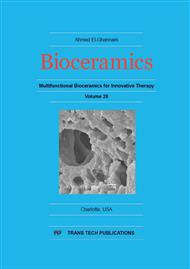p.147
p.153
p.157
p.162
p.167
p.175
p.180
p.185
p.189
Mechanical Strength Improvement of Apatite Cement Using Hydroxyapatite/Collagen Nanocomposite
Abstract:
The combination of tetracalcium phosphate (TTCP; Ca4(PO4)2O) and dicalcium phosphate anhydrous (DCPA; CaHPO4) which are known as one system of apatite cements already used in the medical and dental application. In spite of several advantages of apatite cements, such as self-setting ability and biocompatibility, their mechanical strengths are still low. The aim of this study is to improve the mechanical strength of the TTCP-DCPA apatite cement using the hydroxyapatite/collagen nanocomposite (HAp/Col). The apatite cement powder was prepared using an equimolar TTCP and DCPA with addition of 10% and 20% of the HAp/Col. That without the HAp/Col was used as a control group. Each group was mixed with 1 mol/L Na1.8H1.2PO4 aqueous solution at powder/liquid ratio of 0.5 and hardened at 37°C and 100 % of relative humidity for 24 hours. A setting time of the cement was evaluated using Vicat needle according to ISO 1566 for dental zinc phosphate cements. Morphology of the cements set were observed by the scanning electron microscopy (SEM), and crystalline phases were identified by the powder X-Ray diffractometry (XRD). The mechanical strength of the cement set was evaluated by the diametral tensile strength (DTS). The setting times of cements were the shortest for the cement with HAp/Col and the longest for the control. XRD patterns of the cement at 24 hours after mixing revealed that all cements changed into apatite from the mixture of TTCP and DCPA. The DTSs of cements were the highest for the cement with 20% HAp/Col and the lowest for the control with significant differences between the cement with 20 % HAp/Col and respective other two cements. The scanning electron micrographs of the surface and fracture surface of the cements suggested that the cement with HAp/Col showed denser structure in comparison to the control and the HAp/Col fibers and/or sheets covered the fracture surface. The HAp/Col would act as reinforcement fibers as well as an adhesive of apatite granules formed by the reaction between TTCP and DCPA. The setting time and mechanical strength of apatite cement was statistically significant improved by adding 20% HAp/Col.
Info:
Periodical:
Pages:
167-172
Citation:
Online since:
November 2016
Authors:
Keywords:
Price:
Сopyright:
© 2017 Trans Tech Publications Ltd. All Rights Reserved
Share:
Citation:


